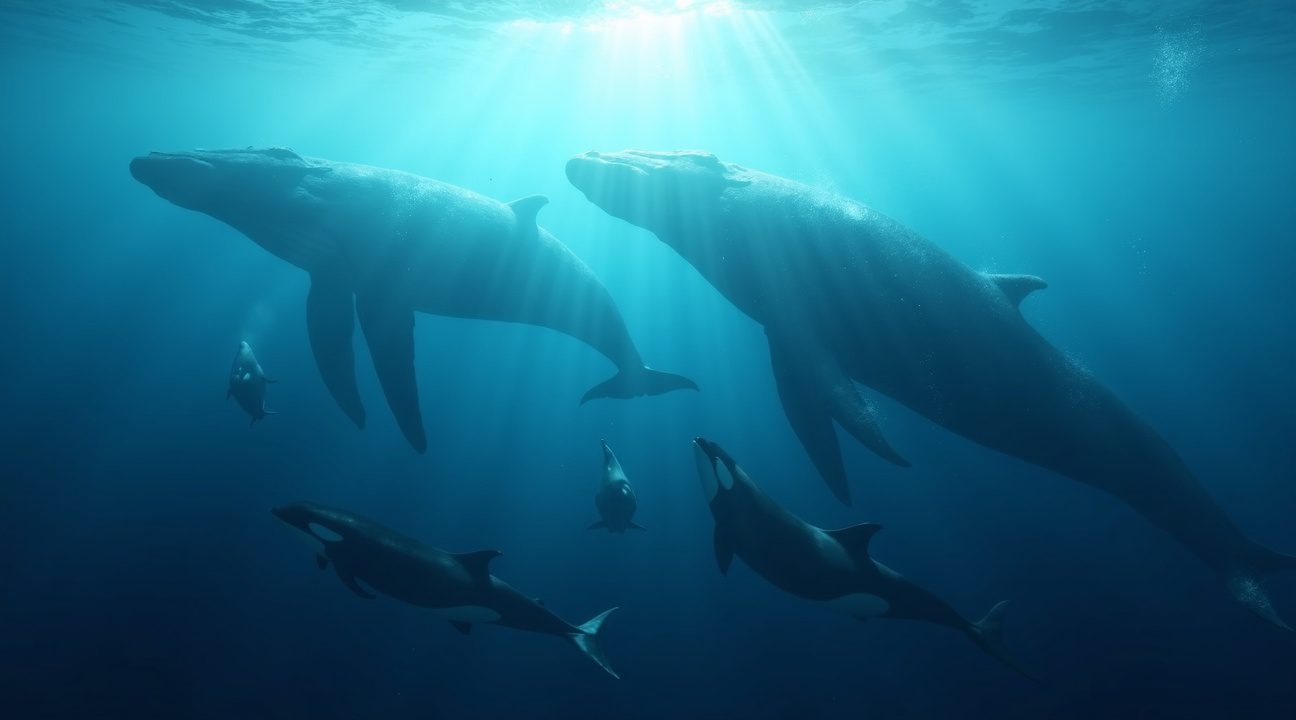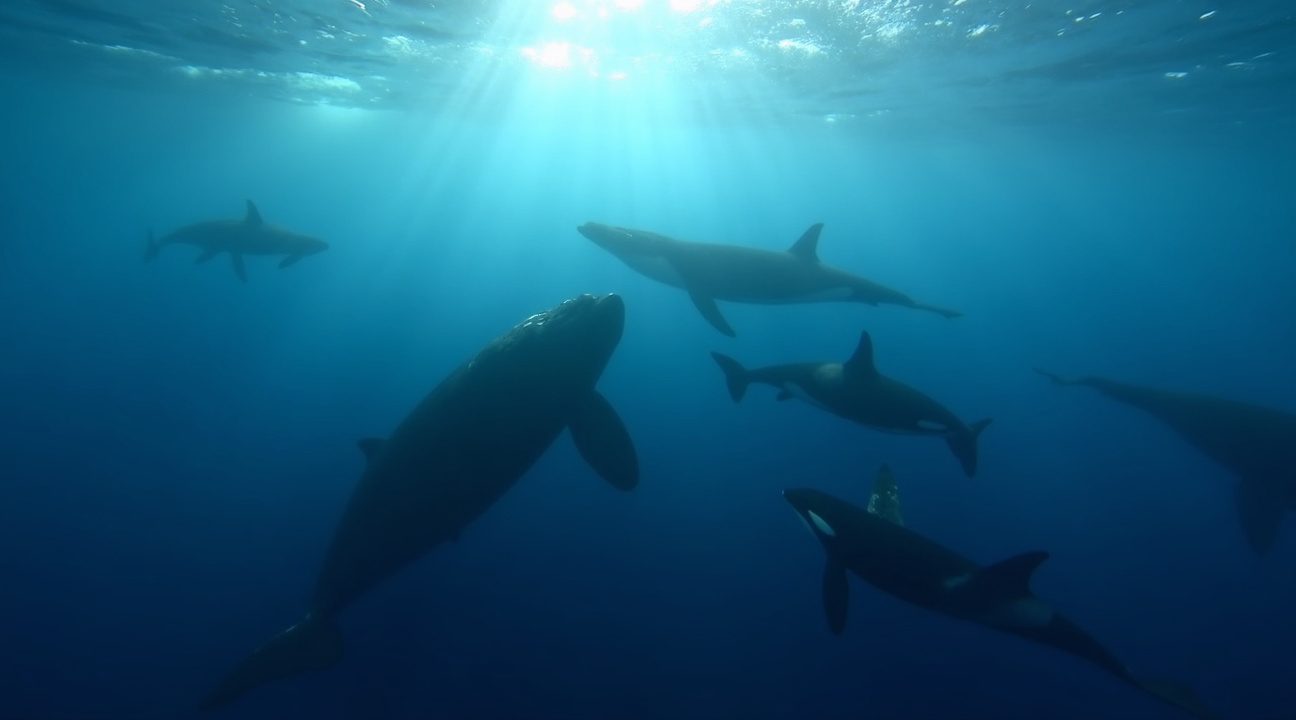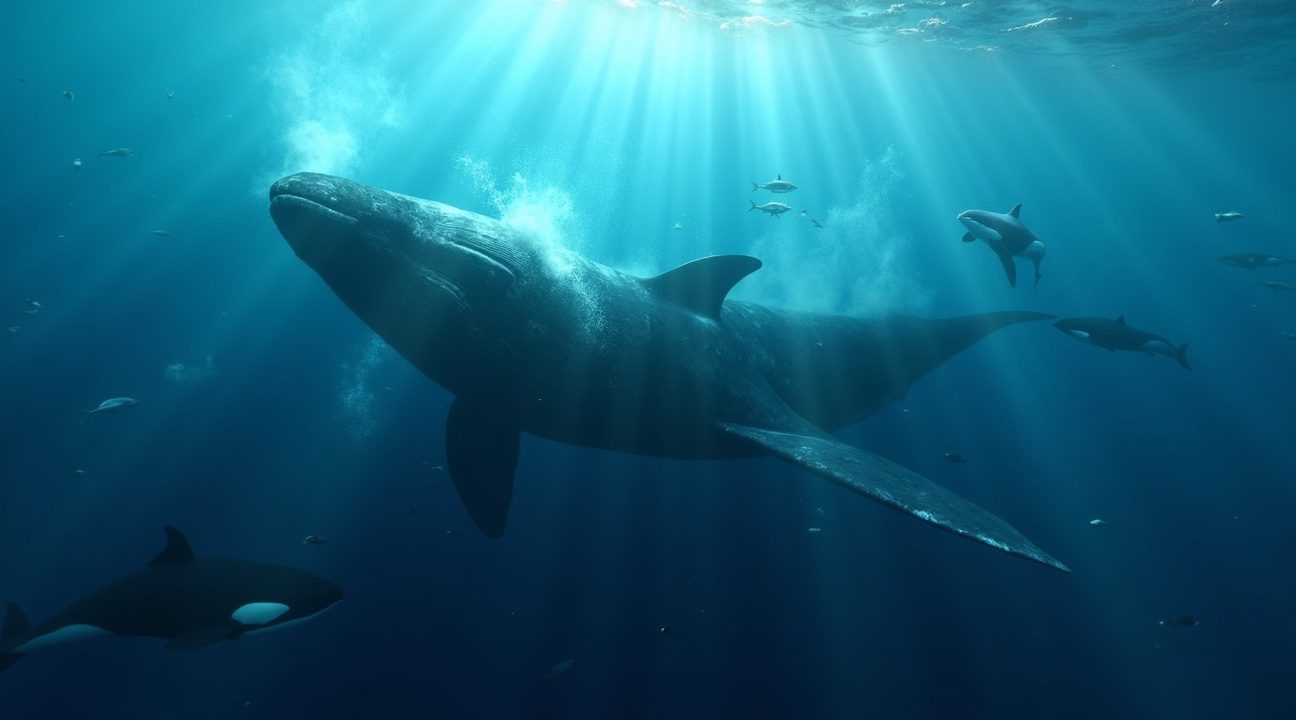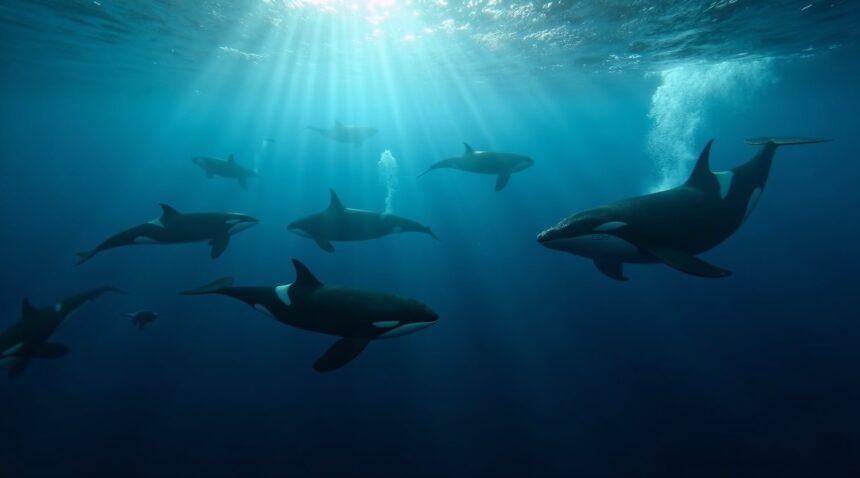Marine biologists have documented over 115 interactions where humpback whales actively intervene in orca hunts, often placing themselves at great risk to protect other marine life without apparent personal benefit.
Key Takeaways
- Humpback whales intervene in orca hunts 89% of the time when the target is a non-humpback species. They often travel large distances to the scene, using their massive 40-ton bodies as physical shields.
- These protective interventions come with high physical and energetic costs, including the danger of confronting orcas with aggressive and violent defense tactics, sacrificing feeding opportunities, and disrupting migratory behaviors.
- Scientists have proposed three main theories for this behavior:
- Misdirected maternal instincts—humpbacks may respond to the distress calls of any mammal as if it were their own calf.
- Interspecies altruism—this behavior mirrors the mobbing seen in birds, where multiple individuals harass predators to deter hunting.
- Evolutionary holdover—a reflexive response to predation cues, possibly hardwired into humpbacks over time.
- The behavior has been observed across diverse regions, suggesting it is not learned or limited to localized social groups but may be an innate trait common to humpback populations globally.
- This phenomenon challenges basic evolutionary assumptions, as the whales gain no discernible reward, yet routinely put themselves in harm’s way to defend unrelated species.
For further reading, check out this National Geographic article on humpback whales and their protective interventions.
Mysterious Ocean Heroes: Humpback Whales Risk Everything to Save Strangers From Killer Whales
I’ve witnessed something extraordinary happening beneath the waves that challenges everything scientists thought they knew about marine behavior. Humpback whales are putting themselves in danger to protect complete strangers from orca attacks, and their motivations remain one of the ocean’s most puzzling mysteries.
The Remarkable Pattern of Protection
Marine biologists have documented an astounding pattern of intervention behavior that spans the globe. A comprehensive study analyzing 115 interactions between humpback whales and orcas revealed something unprecedented in the animal kingdom. These gentle giants actively disrupted killer whale hunts in nearly 90% of scenarios where the prey wasn’t another humpback whale.
The scope of their protective behavior extends far beyond their own species. Humpbacks have been observed defending:
- Seals struggling to escape orca pods
- Sea lions being pursued by hungry killers
- Dolphins caught in coordinated attacks
- Whale calves from entirely different species
- Gray whale mothers and their young
What makes this behavior even more remarkable is that humpbacks often arrive at the scene without any apparent distress calls from the victims. In 57% of recorded cases, the humpback whales initiated the confrontation themselves, suggesting they’re actively seeking out these dangerous situations rather than simply responding to nearby commotion.
Risking Everything for Strangers
The physical risks these whales take during their interventions can’t be overstated. Orcas are apex predators with razor-sharp teeth and sophisticated hunting strategies, while humpbacks are primarily filter feeders with no natural weapons except their massive size and powerful tail flukes. Yet they consistently position themselves between predators and prey, using their bodies as living shields.
I find it fascinating that only 11% of the documented interventions involved orcas actually hunting humpback calves. This means 89% of the time, these whales were risking injury or death to protect animals they had no biological imperative to save. Research in marine biology continues to reveal surprising behaviors in ocean depths, but few discoveries match the altruistic nature of humpback whale interventions.
The mobbing behavior displayed by humpbacks during these encounters resembles defensive strategies seen in some bird species, but it’s virtually unheard of among marine mammals of this size. Groups of humpbacks will sometimes work together to create chaos around hunting orcas, trumpeting loudly and using their massive flippers to splash and disorient the predators.
Scientists have proposed several theories to explain this behavior, ranging from misdirected maternal instincts to learned responses from past orca attacks on humpback calves. However, none of these explanations fully account for the consistency and apparent intentionality of the interventions. The fact that humpbacks frequently travel significant distances to reach orca hunting sites suggests a level of decision-making that challenges traditional understanding of whale cognition.
The protective instincts displayed by these ocean giants appear to transcend species boundaries in ways that scientists are still trying to comprehend. Each documented case adds another piece to a puzzle that may ultimately reshape how researchers understand intelligence, empathy, and social behavior in marine mammals. The humpback whale’s willingness to confront dangerous predators for the sake of unrelated species represents one of nature’s most compelling examples of interspecies altruism, leaving marine biologists with more questions than answers about what drives these mysterious ocean heroes.

The High-Stakes Battle: How Humpbacks Take On Killer Whales
I find it fascinating how humpback whales transform from gentle giants into fierce combatants when confronting orcas. These massive cetaceans leverage every physical advantage they possess to disrupt killer whale hunts, creating dramatic underwater battles that scientists are only beginning to understand.
Physical Dominance Through Size and Strength
Adult humpbacks bring overwhelming physical superiority to these confrontations. Reaching nearly twice the length of an orca and weighing many times more, they possess the raw power needed to challenge these apex predators. Each humpback’s massive pectoral fins become weapons of war—stretching over 5 meters long and weighing approximately a ton each, these appendages can deliver devastating blows to approaching orcas.
The whales employ their entire bodies as defensive shields, positioning themselves between orcas and their intended prey. This body-blocking strategy forces killer whales to expend extra energy maneuvering around the humpback barrier, often disrupting their coordinated hunting patterns entirely.
Combat Tactics and Behavioral Arsenal
Humpbacks deploy a sophisticated range of aggressive behaviors during these encounters. They create thunderous trumpeting noises that can be heard across vast ocean distances, potentially serving as both intimidation tactics and calls for reinforcement from other humpbacks in the area. Violent tail slaps against the water’s surface generate powerful shockwaves that can disorient orcas and their prey alike.
Aggressive swimming patterns become another crucial element of their defensive strategy. Humpbacks exhibit remarkable endurance during these confrontations, including:
- High-speed pursuit of fleeing orcas across multiple kilometers
- Rapid direction changes to intercept killer whale movements
- Sustained physical contact and ramming behaviors
- Coordinated group responses when multiple humpbacks participate
These battles demand extraordinary commitment from the humpbacks. Confrontations can extend up to two kilometers in distance and persist for as long as seven hours. Such prolonged engagements require massive energy expenditure, putting the defending whales at risk of exhaustion and potential injury from orca retaliation.
The persistence these giants demonstrate seems almost inexplicable. They continue their interference despite receiving no apparent benefit for themselves—no food reward, no territorial gain, no protection of their own offspring. This behavior puzzles researchers who typically expect animal interactions to follow clear cost-benefit calculations.
What makes these encounters even more remarkable is the calculated risk humpbacks accept. Orcas remain formidable predators capable of inflicting serious damage, especially when working in coordinated pods. Yet humpbacks repeatedly choose confrontation over avoidance, suggesting powerful evolutionary or learned motivations that scientists haven’t fully decoded.
Marine research discoveries continue revealing surprising behaviors in ocean ecosystems, but the humpback-orca dynamic represents one of the most puzzling interspecies interactions documented in recent years. Each recorded encounter adds another piece to this behavioral puzzle that challenges our understanding of whale social dynamics and motivations.
The intensity and frequency of these confrontations indicate this isn’t random behavior but rather a deliberate pattern that humpbacks have developed over time. Whether driven by protective instincts, learned behavior, or deeper evolutionary programming remains an active area of scientific investigation.
Dramatic Rescues Caught on Camera: Real Stories From the Ocean
Marine biologists have documented an extraordinary phenomenon spanning over six decades, with more than 100 recorded incidents between 1951 and 2012 showing humpback whales actively intervening in orca predation events. These remarkable interactions reveal a consistent pattern of protective behavior that continues to puzzle researchers worldwide.
The Monterey Bay Intervention
One of the most compelling cases occurred in 2012 in Monterey Bay, where observers witnessed humpback whales physically positioning themselves between a hunting pod of orcas and a vulnerable gray whale calf. The humpbacks created an impenetrable barrier, using their massive bodies as shields while the mother gray whale and her calf escaped to safety. This incident exemplified the calculated nature of these interventions, demonstrating that humpbacks don’t simply react—they strategically position themselves to maximize protection.
Another unforgettable moment captured on camera showed a seal desperately seeking refuge by climbing onto a humpback’s belly. The whale remained motionless at the surface, allowing the pinniped to rest safely on its massive frame while orcas circled below. Such behavior contradicts typical whale responses to foreign objects on their bodies, suggesting a deliberate act of sanctuary provision.
Global Patterns of Protection
Research reveals that humpback protective behaviors include several distinct tactics that demonstrate remarkable intelligence and coordination:
- Creating loud warning vocalizations to alert potential prey
- Forming defensive formations around threatened animals
- Actively pursuing orcas to disrupt hunting strategies
- Using their powerful pectoral fins to create barriers
While pinnipeds represent the majority of rescued animals, humpbacks have been observed protecting an astonishing variety of marine life. Dolphins, gray whales, ocean sunfish, and even juvenile orcas have benefited from these interventions. Marine researchers continue discovering unexpected behaviors in deep ocean environments, adding to our understanding of complex whale interactions.
These protective actions span the globe, from California’s coastal waters to the remote Antarctic seas. The consistency of this behavior across different humpback populations suggests an inherent drive rather than learned regional behavior. Each documented case adds another piece to the puzzle of why these gentle giants risk their own safety to protect species they’ve never encountered before.

Scientists Stumped: Three Leading Theories Behind This Bizarre Behavior
Despite decades of observation, marine biologists find themselves scratching their heads when it comes to understanding why humpback whales consistently interfere with orca hunts. The behavior appears to offer no obvious benefit to the humpbacks, yet they continue to risk injury and expend considerable energy to disrupt killer whale predation events across the globe.
Three Competing Theories Emerge
Scientists have developed several compelling explanations for this puzzling phenomenon:
- Misplaced parental instinct suggests humpbacks respond to distress calls without identifying the actual species in danger, potentially mistaking other marine mammals for their own calves.
- Interspecies altruism or mobbing behavior indicates these giants may be engaging in a rare form of cross-species cooperation to collectively deter predators.
- Maladaptive evolutionary holdover proposes that ancient survival instincts trigger responses to general predation cues, regardless of which species is involved.
The first theory centers on maternal confusion. Humpback mothers display incredibly strong protective instincts when their calves face danger, and researchers speculate that distress vocalizations from other marine mammals might trigger these same defensive responses. The acoustic signatures of panic could fool humpback brains into believing their own offspring need protection, leading to immediate intervention regardless of the actual species being hunted.
Interspecies altruism presents an even more fascinating possibility. While uncommon in the animal kingdom, some species do engage in mobbing behavior where multiple individuals band together to chase off threats. Birds frequently demonstrate this strategy when crows collectively harass hawks or owls. Humpbacks might be employing a similar tactic, recognizing that orcas pose potential threats to many marine species and acting preemptively to discourage hunting activity in their vicinity.
The evolutionary holdover hypothesis suggests these interventions represent a biological glitch rather than purposeful behavior. Ancient survival programming might compel humpbacks to respond to certain predation scenarios automatically, even when logic would dictate staying away. This hardwired response could persist because it occasionally benefits the species, despite appearing counterproductive in many individual cases.
Research into marine behavior continues to reveal surprising connections between different species, though the humpback-orca dynamic remains particularly mystifying. What makes this behavior especially perplexing is the apparent lack of reciprocal benefits. Humpbacks don’t seem to gain protection, food, or territory from their interventions, yet they persist in putting themselves at risk.
The energy expenditure alone should deter such behavior. Adult humpbacks can weigh up to 40 tons, and rapidly accelerating to interrupt an active hunt requires tremendous physical effort. Additionally, orcas are apex predators fully capable of turning their attention from their original prey to these interfering giants. Several documented cases show orcas responding aggressively to humpback interference, suggesting the risk of injury or death is very real.
Scientists continue to gather data from around the world, hoping patterns will emerge that might favor one theory over others. The behavior has been documented in multiple ocean basins and appears consistent across different humpback populations, suggesting it’s deeply ingrained rather than learned from specific regional circumstances.
Currently, no single explanation adequately accounts for all observed instances of this behavior. Some interventions seem to align more closely with the parental instinct theory, particularly when young marine mammals are involved. Others appear more consistent with mobbing behavior, especially when multiple humpbacks coordinate their efforts. Still others might represent evolutionary misfiring, particularly when humpbacks intervene in situations where no apparent distress signals are present.
The mystery deepens as researchers realize they’re witnessing something unprecedented in marine biology — a large whale species consistently risking its own safety to protect other species with no apparent reward. Until more definitive evidence emerges, humpback whale motivations remain one of the ocean’s most intriguing unsolved puzzles.

The Hidden Costs: What Humpbacks Sacrifice to Play Hero
Humpback whales pay a substantial price for their heroic interventions in orca hunts. I observe that these massive creatures routinely abandon their most essential life activities to rush into dangerous confrontations with apex predators.
When humpbacks detect distress calls from marine mammals under attack, they often abandon feeding opportunities that they desperately need. These whales must consume enormous quantities of krill and small fish during their feeding seasons to build the fat reserves necessary for long migrations and reproduction. Each intervention can cost them hours or even days of valuable feeding time in areas where food concentrations might be optimal.
Migration patterns also suffer significant disruption when humpbacks choose to play protector. These whales follow precise seasonal routes spanning thousands of miles between feeding and breeding grounds. Detouring to intervene in orca attacks can add substantial distance to their journeys, forcing them to expend additional energy reserves they can’t easily replace.
Physical Toll and Energy Expenditure
The physical demands of confronting orcas create serious energy deficits for humpbacks. I’ve learned that these interventions require intense bursts of speed and aggressive maneuvers that burn through precious fat stores. Racing to reach attack sites, engaging in prolonged physical confrontations, and maintaining defensive positions around vulnerable prey animals all demand enormous energy expenditures.
Injury risks escalate dramatically during these encounters. Orcas possess sharp teeth and exceptional coordination as pack hunters, making any confrontation potentially dangerous for intervening humpbacks. Even minor injuries can become infected or impair swimming efficiency, creating cascading effects on a whale’s ability to feed, migrate, or reproduce successfully.
Perhaps most remarkably, humpbacks make these sacrifices even when protecting species completely unrelated to their own survival interests. Marine research continues to reveal the complex behaviors of ocean dwellers, yet humpback intervention patterns remain particularly puzzling. They’ll risk everything to save seals, sea lions, dolphins, or even gray whale calves – animals that provide no reciprocal benefits or evolutionary advantages to their own species.
Social behaviors also take a backseat to rescue missions. Humpbacks engage in complex social interactions during feeding and breeding seasons, including:
- Cooperative feeding strategies
- Mating displays
- Mother-calf bonding activities
Interrupting these critical social periods to chase off orcas can disrupt reproductive success, learning opportunities for young whales, or cooperative relationships that enhance survival chances.
The cumulative effect of repeated interventions can create chronic stress on individual humpbacks. Those whales that respond most frequently to distress calls may experience:
- Reduced overall fitness
- Compromised immune systems
- Decreased reproductive success
Energy reserves meant for surviving harsh migration periods or nursing calves get diverted into altruistic activities that provide no apparent personal benefit.
Temperature regulation becomes another concern during extended confrontations. Humpbacks must maintain optimal body temperatures across vast ocean ranges with varying water conditions. Prolonged physical exertion in cold waters or extended surface activity in warm regions can disrupt their carefully balanced thermal regulation systems.
Despite these significant costs, humpbacks continue displaying this behavior across global populations. Their willingness to sacrifice feeding time, migration efficiency, social opportunities, and physical safety for the protection of other species represents one of the most selfless behaviors documented in marine mammals. The fact that they persist in these interventions suggests either an incredibly strong biological drive or learned behavior that somehow benefits their species in ways scientists haven’t yet identified.
Understanding these sacrifices helps illuminate just how extraordinary humpback intervention behavior truly is, making their motivations even more mysterious and compelling for researchers studying marine mammal cognition and social behavior.
A Marine Mystery That Challenges Everything We Know About Animal Behavior
The ocean harbors countless mysteries, but few are as perplexing as the deliberate actions of humpback whales confronting killer whales during hunting events. I’ve observed through research documentation that these massive cetaceans consistently intervene when orcas pursue prey, creating a behavioral pattern that defies conventional scientific understanding.
This protective behavior stands alone in marine biology. No other oceanic mammals demonstrate similar rescue actions across multiple species, making humpbacks uniquely altruistic among their peers. Scientists have documented these interventions involving seals, sea lions, dolphins, and even gray whale calves — species with no familial or survival connection to the intervening humpbacks.
The consistency of these confrontations puzzles researchers worldwide. Unlike sporadic territorial disputes or accidental encounters, humpback interference appears purposeful and calculated. These whales actively seek out orca hunting parties, traveling considerable distances to reach predation sites. Once there, they position themselves between predators and prey, using their massive size and powerful tail flukes to disrupt successful hunts.
Breaking the Rules of Evolutionary Behavior
Traditional evolutionary theory suggests animals prioritize self-preservation and the survival of genetically related individuals. Humpback intervention behavior challenges these fundamental principles by extending protection to completely unrelated species. I find this particularly striking because these actions offer no apparent benefit to the humpbacks themselves while potentially exposing them to injury from aggressive orcas.
Consider the energy expenditure involved in these encounters. Adult humpbacks can weigh up to 40 tons and must exert tremendous effort to travel to hunting sites and engage in physical confrontations.
This energy could otherwise support:
- Feeding
- Migration
- Reproductive activities
— all crucial for individual survival and species propagation.
The risk factor adds another layer of complexity to this mystery. Killer whales, despite their smaller size, hunt in coordinated pods and possess formidable intelligence and aggression. Marine research continues to reveal surprising animal behaviors that challenge our understanding of ocean ecosystems. Humpbacks engaging these apex predators face potential injury from powerful jaws and coordinated attacks, yet they persist in their protective actions.
Scientists struggle to categorize this behavior within existing frameworks of animal psychology and evolutionary biology. Altruism typically occurs between related individuals or within social groups where reciprocal benefits exist. Humpbacks demonstrate neither relationship with their rescued prey nor expectation of future assistance.
The phenomenon forces researchers to reconsider fundamental assumptions about empathy and consciousness in marine mammals. These interventions suggest cognitive processes that extend beyond basic survival instincts, hinting at emotional complexity previously unrecognized in cetacean behavior.
Documentation spans multiple ocean regions and involves different humpback populations, indicating this isn’t learned behavior specific to particular groups. Instead, the pattern suggests an innate drive that transcends geographic boundaries and individual whale communities.
Current hypotheses range from misdirected maternal instincts to complex social learning, yet none fully explain the consistency and cross-species nature of these protective actions. Some researchers propose that humpbacks recognize distress calls from various marine mammals and respond instinctively, while others suggest these whales possess a sophisticated understanding of predator-prey dynamics.
The mystery deepens when considering that humpbacks don’t intervene in all orca hunts. They selectively respond to certain predation events, suggesting decision-making processes that remain completely opaque to scientific observation. This selectivity implies these whales can assess situations and choose when to act, adding another layer of cognitive complexity to an already puzzling behavior.
This phenomenon represents one of marine biology’s most compelling unsolved mysteries, challenging established theories about animal motivation, intelligence, and interspecies relationships. Until researchers crack this behavioral code, humpback whale interventions will continue to reshape our understanding of consciousness and empathy in the ocean’s most magnificent creatures.
https://www.youtube.com/watch?v=DV5I3xQ3qNM
Sources:
The Animal Rescue Site – Humpback Whales Intervene in Killer Whale Hunts
Baleines en Direct – Why Do Humpback Whales Get in the Way of Hungry Killer Whales?
Baleines en Direct – Are Humpback Whales Saving Other Species Being Hunted by Killer Whales?
Marine Mammal Science (Wiley) – Article DOI: 10.1111/mms.12343
Michele Gargiulo – The Whale That Would Not Let Death Pass: Why Humpbacks Keep Crashing Orca Hunts


